Mansard is an attic room that can be used as a dwelling. An attic roof should ensure the normal functioning of such a room. During the construction of the roof, a rafter design is commonly used, and the step between the attic roof rafters is an important indicator of its reliability.
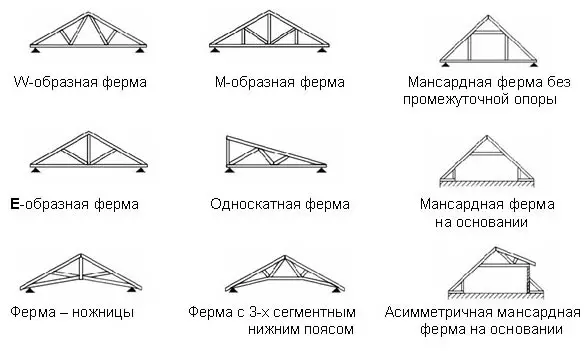
Types of rafter systems.
Huge loads caused by the weight of the roof, wind, climatic factors are perceived by the Stem System. The distance between the roof rafters of the attic type determines which part of the load is to each element. Only the right choice of distance will ensure the stability of the whole roof.
Mansard: System Features
The rafters are called carrier beams on which protective, additional and outer coatings of the attic roof are attached.
Elements are usually made in the form of a durable wooden bar or a bottle with a thickness of at least 50 mm. Sometimes log can be used. For particularly durable buildings, metal and reinforced concrete beams are used.
For the roof of the attic, one of two variants of the rafter systems (change in or suspension) is used, as well as a combination of both options in one design. The utility type is characterized by a support of each of the rafted on the wall of the structure. The suspension type implies linking elements into a common frame that is fixed only on extreme supports.
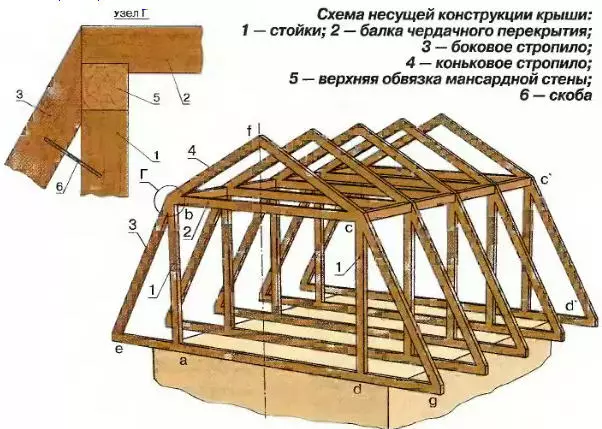
The scheme of the raffle system of the broken roof of the attic.
By what type of the rafter system is used, the attic roofs are conditionally divided into the following types: single-sided, duplex, broken, hip, tent and vaulted. In private construction, a single, double or broken roof has the most widespread use. In a single-sided roof, the rafter is based on the walls of different height, which provides the tilt (skate) of the roof in one direction. The bartal roof has two inclined planes, each of the rafters, one end relies on the wall, and the second end is connected to another beam. Such a design forms a triangle, and the angle between the elements determines the steepness of the skate. The broken roof also has two skates, but each of them has a break line in which the angle of laying is changing.
FEATURES OF MONTAGE
When installing the rafter system, the roof of the attic uses fastening and installation of rafters in the form of simple geometric shapes. The highest rigidity (durability) is linked to the triangle, which is used in the construction of an attic roof. Thus, the most common bartal roof includes a number of triangles from rafters, connected by longitudinal lags (runs). Linking rafters in a triangle provides a lower transverse beam (Mauerlat). To facilitate the fastening of the external coating of the roof and the redistribution of its weight on the rafters, the lattice is made in the form of transverse bars or boards.
Article on the topic: Garden benches Photo
The broken roof combines two types of rafal compounds. The lower rafters using Maurolat and the racks are connected to the rectangular triangles, which, in turn, are fastened with a longitudinal run of each other. At the bottom of the rafter of the attic rest on the wall of the house. The top is connected to the triangle by analogy with a bartal design.

Figure 1. Bruse sections table for rafters.
The lower end of the rafter is fixed on the transverse lag, and the upper ends are connected together through the longitudinal top run. The lower corners of the bonded triangle are connected to each other using the longitudinal bottom run. The system formed by hanging rafters is fixed on the lower rafter system. Additional vertical racks are used to strengthen the upper triangles. Thus, the attic roof is on each side the surface with a break. From the wall begins with a greater steepness, and then it acquires a more gentle look.
The connection of the rafted attic of the attic with longitudinal bars (including with the ceiling beam) is produced by the method of Slingel in the bar on a third of its height. Fixing on transverse beams is advisable to produce a screw connection. With such fasteners, the functions of two different rafal systems are separated, and they are calculated as separate systems.
Parameters taken into account when choosing rafters
When choosing the design of the rafter system, the size of the timber and the number of elements is important to account for all loads that affect the rafyled. These loads can be divided into permanent and temporary, periodic or short-term character. Under the permanent load, the weight of all the elements of the attic roof should be taken: the solid construction with grille itself, the outer roofing flooring, additional protective and insulation layers, the elements of the attachment of the attic. The weight of the outer roof can vary violently depending on the type and coating material.
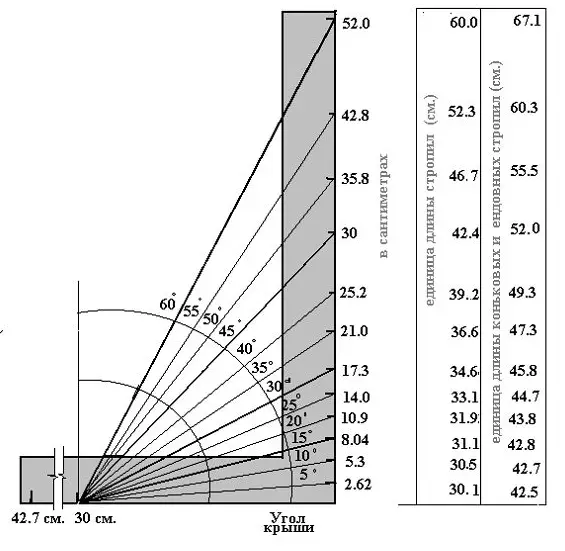
The diagram of the length of the length of the rafters from the angle of inclination of the roof.
As temporary or periodic loads, natural factors should be taken into account. This is, first of all, the weight of snow in the winter. A significant impact is the wind, and the direction of such a load may be different. For some districts, this factor may become decisive. It is impossible to ignore the possibility of storm water flows. In addition, it is necessary to take into account the weight of people and materials when carrying out repair work on the roof.
Article on the topic: Load on the loggia and balcony
The geometry of the roof and the rafter system has a significant effect on the load distribution. The basic parameters can be attributed to the length and width of the roof, as well as the steepness of the skate. The length of the roof strongly affects the load distribution, so with a high length it is necessary to use the reinforcing vertical racks. An increase in the width of the roof leads to an increase in the load on all the attic rafters, since their length and the total weight of all elements increase. For widespread roofs, the broken type is more suitable due to the presence of intermediate vertical racks and the redistribution of loads between different rapid systems.
The change in the ridge of the skate affects the parameters ambiguously. The increase in the steepness, on the one hand, reduces the accumulation of snow cover and redistributes the load on the bearing walls of the house, on the other hand, the length of the rafter and the roof sailiness increases, which is dangerous in windy areas. The concentration of loads on the walls can also adversely affect the reliability of the house, because with a decrease in loads on the rafyl, constant loads on the wall laying are increasing.
Requirements for the material of the rafter system
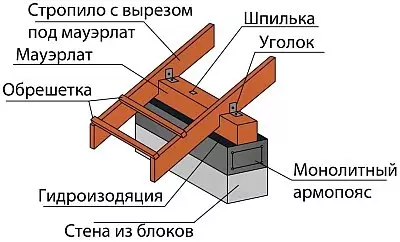
The attachment knot rafters to Mauerlat.
The calculation of the number of rafters and installation parameters is based on the construction of high-quality material applied. In this connection, the material should be selected for the solo system, based on the following conditions.
As the main rafters, only a high-quality timing of at least 50x100 mm should be used.
All wooden elements during installation should be well dried (the allowable moisture content is not more than 15%). The number of even small defects on the bar cannot exceed 3 pieces per 1 m. The tree before installation is processed by an antiseptic. The most well shown the wood of coniferous rocks. Vertical racks are made from a bar with a size of at least 100x100 mm with a check of their vertical location using a plumb.
Features of the calculation of the rafal
After choosing the design of the attic roof (based on the recommendations of specialists and in accordance with the reference data), the main calculation parameters are the distance between the rafters (step of the rafter) and their number. Typically, the distance between the rafters is from 0.6 to 1.5 m. The calculations are based on the fact that the optimal load should be 40-60 kg per 1 m length of the rafter, and the maximum allowable deflection of beams is 1/250 from its length.
Article on the topic: English Curtains do it yourself: two options (photo)
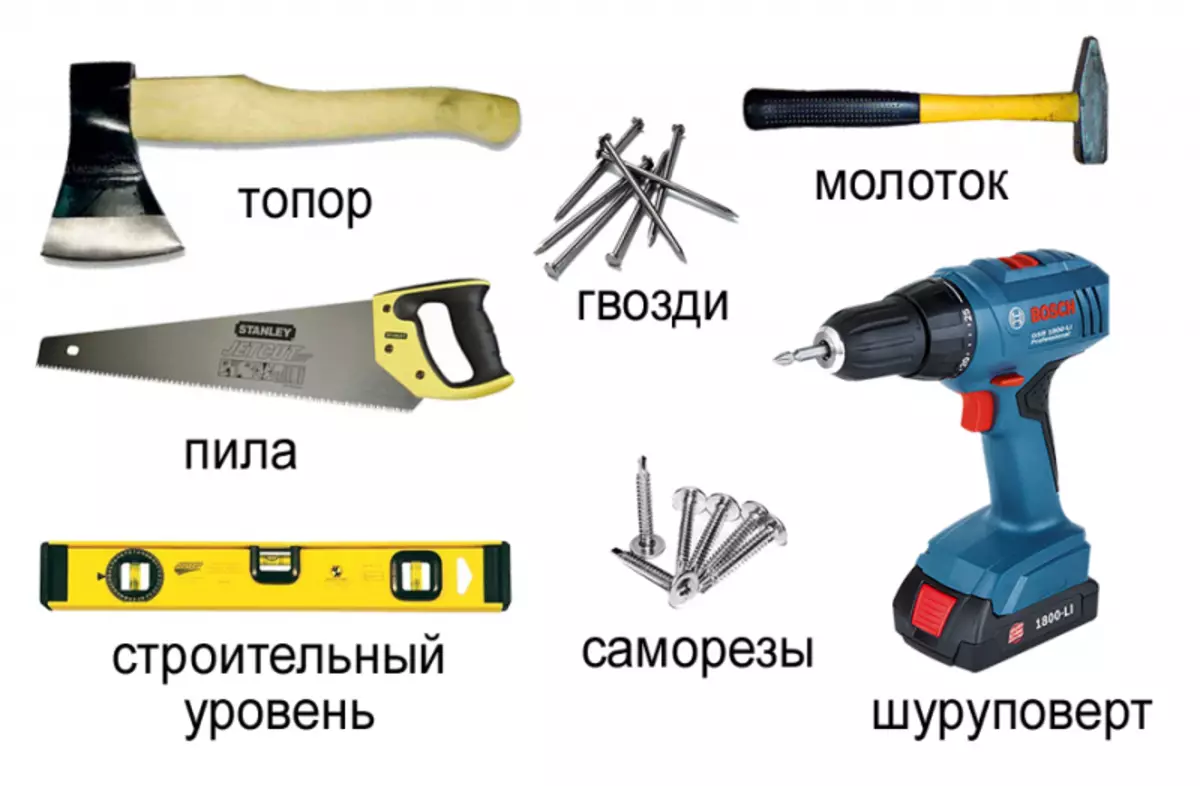
Tools for splicing of rafter feet.
The number of rafters per slope is calculated after measuring the length of the skate and select the distance between the rafters. The length of the skate is divided by the setting step of the rafter, 1 (unit) is added to the result. The result obtained is rounded to the nearest integer in a large side.
The calculation of the distance between the rafters, taking into account all factors, can produce a specialist, but in practice, use reference guidelines. For example, for rafters from a board of 50x180 mm and a slope length of 3 M average step is 1.5 m; with a length of 3.5 m - 1.2 m; And with a length of 4 m - 0.9 m.
Distance between rafyles for different roofs
The distance between the rafters is significantly different for the roofs with different coating. Ceramic tile is one of the most severe roofing materials. For rafters from a bar of 50x150-60x180 mm in size, the recommended distance between them is 80-130 mm (depending on) from the row of the skate. With a slope of 15 °, the step is selected equal to 80 cm. With an increase in the length of the rafted, the step is increased within the limits of the recommended one.The distance between the rags for the roofs with a metal tire is set to smaller than for natural tiles. The optimal step is 60-95 cm for a bar of 50x150 mm. When using a coating of a corrugated floor, a step is in the range of 60-90 cm with a sufficient cross section of a bar from 50x100 mm to 50x150 mm.
The easiest coating is obtained when using ondulin. The optimal distance between the 50x50 mm rafters is 60-80 cm and decreases when the larger bar is installed. When coating the roof of the attic of the attic of the slate is used by the ram with a size of 50x100 mm to 50x150 mm. Step is installed in the range of 60-80 cm.
Required tools
When installing rafters on the attic roof, the following tools are used:
- Bulgarian;
- drill;
- hacksaw;
- saw;
- ax;
- chisel;
- a hammer;
- plane.
When installing the rafting system on the attic roof it is important to determine the optimal distance between the rafters. The correct choice of this parameter will allow you to calculate the optimal amount of material and ensure the reliability of the whole roof.
